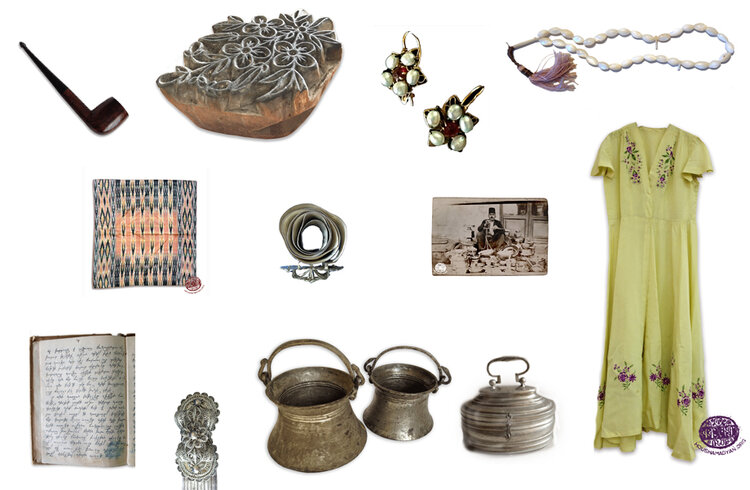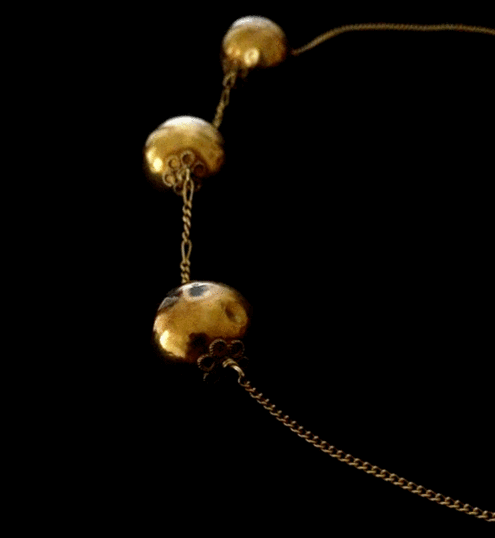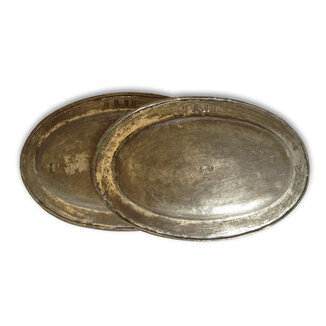Miscellaneous - Armenia
Ekizian family - Yerevan, Beirut
The Ekizian family collection is originally from Malatya. The items are currently with family members in Yerevan and Beirut.
These pearl earrings (later renovated) and three gold globules (later put around a chain) belonged to Yeghisapet (born Gyazourian) Geghgants Ekizian, who was born in 1895 in Malatya. She was a Genocide survivor. In the 1920’s she immigrated to Soviet Armenia. She died in Yerevan on the 9th of September, 1990.
Yeghisapet gave her pearl earrings and the three gold globlules to her granddaughter, Nara Ekizian, who moved to Lebanon and has been living in Beirut since 1980.
Yeghisapet Ekizian and her husband Hovhanness Ekizian
All this copperware and the cross (above) also belonged to Yeghisapet, she brought them with her from Malatya to Soviet Armenia. They are currently in the possession of Yeghisapet’s son, Haroutyoun Ekizian (born 1922) in Yerevan, Armenia. Haroutyoun has always kept the cross above his bed.

Ter-Mikayelyan family - Yerevan
The Ter-Mikayelian family collection is rich with photographic and historical materials, as well as several items that have been passed down from one generation to the next. One of the branches of the family (the Ter-Mikayelians) originated in Arapgir, while another branch of the family (the Ter-Aprahamians) originals in Van. Members of both branches of the family left the Ottoman Empire in the last years of the 19th century and settled in Egypt. Later, in the 1940s and the 1960s, some of them settled in Soviet Armenia, taking some of their family heirlooms with them. Many of the materials we are presenting here are currently kept by the Ter-Mikayelian family in their Yerevan residents, while some others are kept by Armenian public institutions. We owe much of the biographical information regarding this family to Nubar Ter-Mikayelian (1917-1997), who moved from Cairo to Yerevan in 1948.
A walking stick, which was most probably made by Manoug Der-Aprahamian. He was born in the Aghka Village in the Van region, in 1840. He married Mariam Tonershinoghian in Van, but, in 1879, left for Egypt as a migrant worker. In 1889 or 1890, Mariam, too, left Van and, and joined her husband in Cairo. They had a daughter, Takouhi (later Ter-Mikayelian). Manoug had many talents. In Cairo, he spent his leisure hours practicing calligraphy, pictography, wood carving, and metal engraving. This walking stick, too, is presumed to be his handiwork. A lion’s head is engraved on the handle, while the pyramids of Giza, a sphinx’s head, an obelisk, and a pharaoh’s head can be seen a bit lower on the stem.
In 1895, Manoug, alongside his compatriot from Van, a man named Asadour, established a small tobacco processing plant, which unfortunately did not remain open for long. Asadour soon died, and the plant was shut down. Some rolling paper produced by the plant has survived to the present day, monogrammed with the names of the two business partners (see picture below, in the left column). In 1900, Manoug, too, died at a young age, and was buried in the Armenian Cemetery of Cairo.
Manoug’s daughter, Takouhi, immigrated to Soviet Armenia in 1962. Manoug’s son, Noubar, had already settled in Soviet Armenia in 1948. This walking stick was moved to Armenia by one of them, and has been kept there since. Currently, it is part of the Ter-Mikayelian collection in Yerevan.
A framed picture of Father Khrimian that was prepared in Cairo in 1894. The occassion for preparing this portrait was Khrimian’s election as Catholicos of All Armenians in 1892. Around the image one can read laudatory writings about Khrimian. Manuk Ter Abrahamian (1845 Van-1900 Cairo) composed the entirety of this work (framed picture and writings on the margins) (Source: Gegham Ter Mikayelyan collection, Yerevan)
Istanbul, 1908. The Ter-Mikayelian family. The photograph was taken on the occasion of Kegham’s brother’s, Krikor’s, and his family’s visit to Istanbul. Seated, from left to right – Boghos Ter-Mikayelian (Kegham’s brother); Satenig Ter-Mikayelian (Kegham’s sister, later Proudian); Tshkhouhi (Kegham’s mother, nee Saghatelian); Hayganitsa (Kagham’s sister-in-law, nee Melikian); and Krikor (Kegham’s brother). Standing, from left to right – Nvart (Kegham’s sister, later Odadjian); Daniel (Kegham’s brother); Roupen (Kegham’s brother); and Nazeni (Kegham’s sister). The children in the first row are Krikor and Hayganitsa’s children. From left to right – Manoushag, Dikranouhi, Dikran, and Araksi.
Diploma from the Istanbul University’s Law School. It belonged to Roupen Ter-Mikayelian (1893-1913). Roupen was born in Arapgir. His father was Mgrditch, and his mother was Tshkhouhi (nee Saghatelian). His grandfather was Father Mikayel Boghosian. Rupen’s father was a prominent owner of a textile factory in Arapgir. In 1895, during the anti-Armenian pogroms in the town, the Ter-Mikayelian clan suffered many casualties, and their three-story house, which included the textile factory, was burned to the ground. After the pogroms, Roupen’s family decided to leave Arapgir and resettled in Istanbul, where Roupen attended, and graduated from, Istanbul University’s Law School. He died at a relatively young age, in 1913.
In 1896, a branch of Roupen’s family moved to Egypt. There, two of his brothers, Kegham (1880-1950) and Krikor (1871-1927) worked at the tobacco processing plant of the Gamsaragan Brothers, which was located in Zagazig. The two brothers would later hold many different positions for the plant, in different cities of Egypt. Kegham married Takouhi Der-Aprahamian in 1916, and had four children – Noubar, Sirvart, Diran, and Alice. Kegham’s son Noubar (in 1948), and later, his widow Takouhi (in 1962) and daughters Alice (in 1963) and Sirvart (in 1974) relocated to Soviet Armenia alongside their families. This diploma has been kept as part of the Ter-Mikayelian family collection in Yerevan.



















